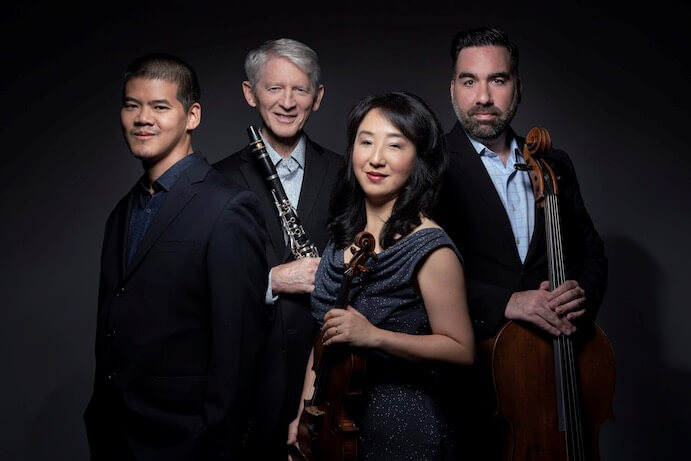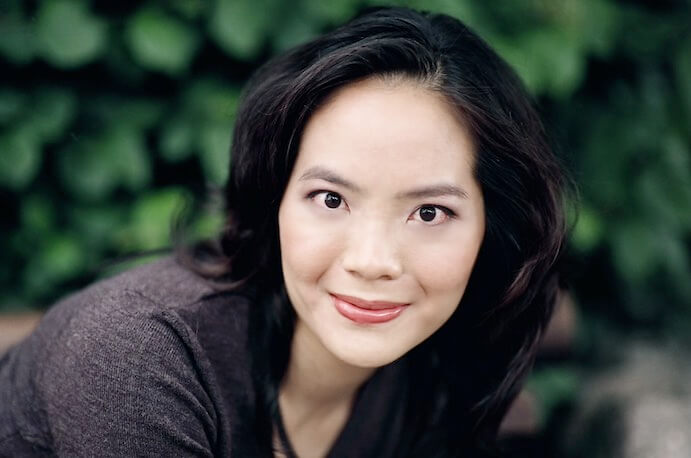Since 2011, Civitas Ensemble has become a fixture of Chicago’s chamber music scene by pushing the boundaries of classical music. The ensemble, comprised of Yuan-Qing Yu (violin), Kenneth Olsen (cello), Lawrie Bloom (clarinet), and Winston Choi (piano), received early critical acclaim by performing “bracing” programs that mixed old standards with newer works. In recent seasons, Civitas has commissioned new music through projects that create space for interdisciplinary collaboration and intercultural exchange. Their newest album, Jin Yin (Cedille 2020), curates recent works by Chinese composers to highlight the rich variety of perspectives on the intersection between Chinese and Western classical music.
Zhou Long’s new arrangement of Five Elements imagines the elemental forces central to traditional Chinese cosmology as cyclical processes that continuously develop fixed sets of musical material. The arrangement on Jin Yin draws from the rich timbral palate and sensitive musicianship provided by Civitas’ core instrumentation alongside guest artists Yihan Chen (pipa virtuoso) and CSO musicians Cynthia Yeh (percussion) and Emma Gerstein (flute/piccolo). In first movement, “Metal,” the ensemble’s impeccable phrasing spins a texture reminiscent of traditional Chinese folk ensembles as breathless melodies and purposive rhythmic gestures cycle through each instrument. The ensemble consolidates around blisteringly fast percussive ostinatos in the second and fourth movements, “Wood” and “Fire,” creating a backdrop for wilder sonic effects from flutter tonguing to timbral trills. “Water” and “Earth,” the third and final movements, showcase brilliant lyrical playing through pensive, circular melodies cast against the swirling ebbs and flows of delicate percussive and pitched textures. In these tracks and throughout the album, Bill Maylone‘s GRAMMY-nominated sound engineering adds depth to musical textures through nuanced spatialization and expert mastering.

Chen Yi’s Night Thoughts for violin, cello, and piano is inspired by the desolate, moonlit landscape evoked in a short poem by ninth century Chinese poet Li Bai. The poem’s forlorn ethos is heard in meandering atonal melodies passed between the violin and the cello. The trio’s interpretation dramatizes the stark ethereal landscape created by balancing constant variation and rearrangement of motives and gestures with sudden dissonant interruptions. Throughout, Yuan-Qing Yu and Kenneth Olsen effortlessly shift from a resonant tone quality and lyrical style similar to the erhu, to pointillistic melodies, and virtuosic double stop trills and tremolos.
A more eclectic landscape follows in Lu Pei’s new arrangement of Scenes Through a Window. The structure of the work’s overlapping episodes were inspired by American rap music and midwestern landscapes, and the melodic content is infused with the folk melodies and styles of ethnic groups in Southern China. Originally conceived for pipa, erhu, and piano trio, Civitas Ensemble and Gerstein faithfully retain the stylistic characteristics of the folk instruments in overlapping jaunty melodic motives at the piece’s opening. Yielding initially to boisterous rhythmic interjections in the piano and low strings, these tightly constructed melodies gradually unfurl into sprawling scenes, soaring melodies, and expansive sustained open harmonies. The work ends quietly, with a haltering reprise of the opening melody against fading residual harmonies.
Vivian Fung’s Birdsong for Violin and Piano is a spirited tour de force with a wide range of both technical and musical virtuosity. The first half of the work juxtaposes episodes of dazzling passages and heightened lyricism to evoke 20th century violin show pieces. However, the work reaches peak intensity in a freewheeling, quasi-improvisational section that features Yuan-Qing Yu brazenly pushing double stops and gravity defying technical passages into noisy overpressure gestures. Amidst this technical flurry, the impeccable cohesion between Yu and Choi gives the piece musical gravitas, especially in gripping rubato and accelerando passages that connect the episodes.

Recalling the spiritual influence of Zhou Long’s piece, Yao Chen’s Emanations of Tara explores the many entangled facets of the goddess Tara, who, as Dan Albertson writes in the program note, “rescues all living beings from the eternal cycle of life, death and rebirth…” However, the work features only residue of traditional styles, instead capitalizing on Yihan Chen’s adventurous and versatile playing to reimagine traditional techniques to create inventive combinations of sounds. Civitas comes alive as Yao Chen rapidly develops these sonic kernels into rich soundscapes ranging from serene metallic resonance to cacophonous waves of plucky articulations and sonic gestures. The ensemble demonstrates particular interpretative aplomb by clearly tracing musical development while finding unexpected details in each of the work’s five episodes.
After listening to what is ultimately an exceedingly well crafted and utterly satisfying album, one is left to ponder a single looming question: the politics of representing Chinese identity in music. In the West, Chinese culture, music, and musicians have historically been essentialized and exoticized for centuries as a product of colonial and imperial practices. The pieces and performances on Jin Yin talk back to this history, allowing Chinese composers to articulate diverse, nuanced, and multifaceted musical identities. They also create space to reflect and engage in ongoing discussions of the transnational cultural politics of (re)constructing traditional Chinese music and identity in the 21st century. While Jin Yin and Civitas’ intercultural mission do not provide definitive answers, they offer something perhaps more valuable for these hard conversations: possibilities.
























